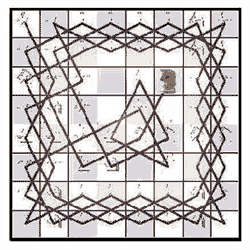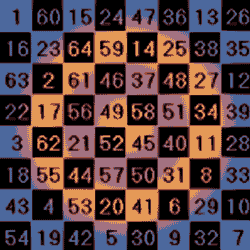Take the Knight Tour Challenge
We will deal with the 8x8 grid as that is the regulation chessboard, this tour to be completed in 64 moves. A closed tour is when the final position is a Knight's move away from the first position. All other tours are known as open tours.
There are an infinite number of solutions but they are difficult to find as you will see. There are also magic tours and semi-magic tours. These get their name through the patterns they take.
Long History of the Tour

Knight Tour: Closed
Not surprisingly, it was originally difficult to work out correct patterns for the tour simply by trial and error. There are literally billions of possible paths the Knight could take across the board so mathematicians were needed to make the breakthrough.
Leonhard Euler (1707-1783) devised a method for plotting a path in 1759. Others like Warnsdorff also contributed significant work on the Knight's Tour riddle.
Give it a Try

Knight Tour Solution
These links will open in a new tab. The diagram shows one of virtually countless solutions. This is something that has sparked a wide interest and there is plenty of related material out there.
I would like to point you to the definitive directory on the Knight's Tour.
Moving On
Bishop Moves
You may find it easier to study the solutions and let others worry about the complicated calculations. Let's face it, trying to work it out on the board is more fun than struggling with the calculator. That is at least until you start pulling your hair out.
Eventually you may feel that you can do with a break from the Knight and certainly the move should be burned into your mind by now. For a change of scenery you can now turn to the Bishop.






